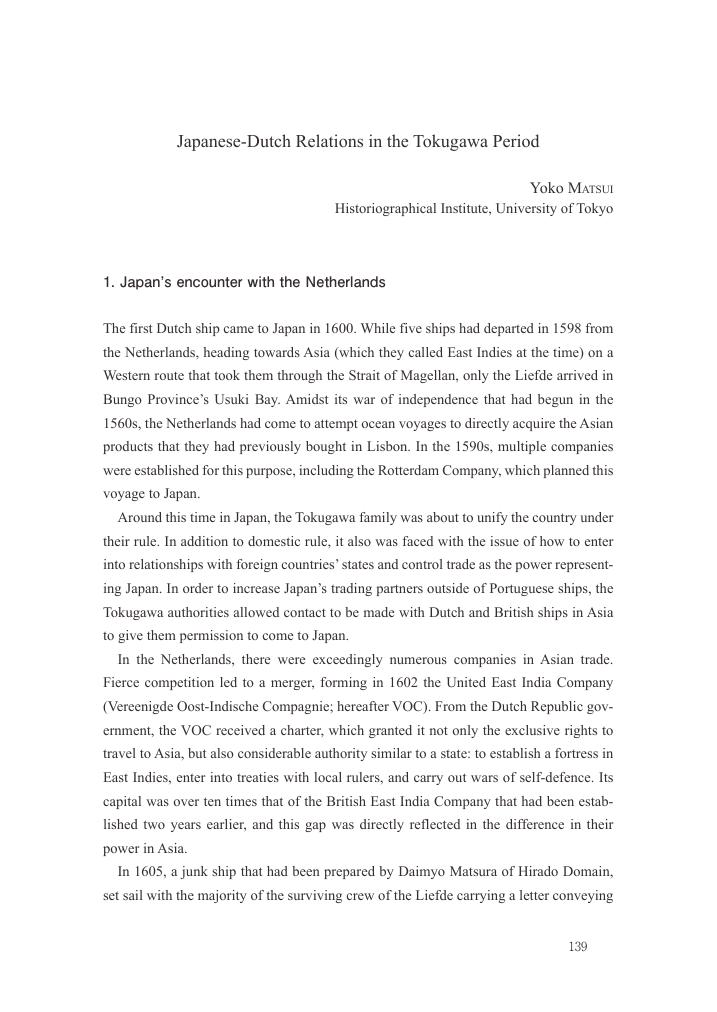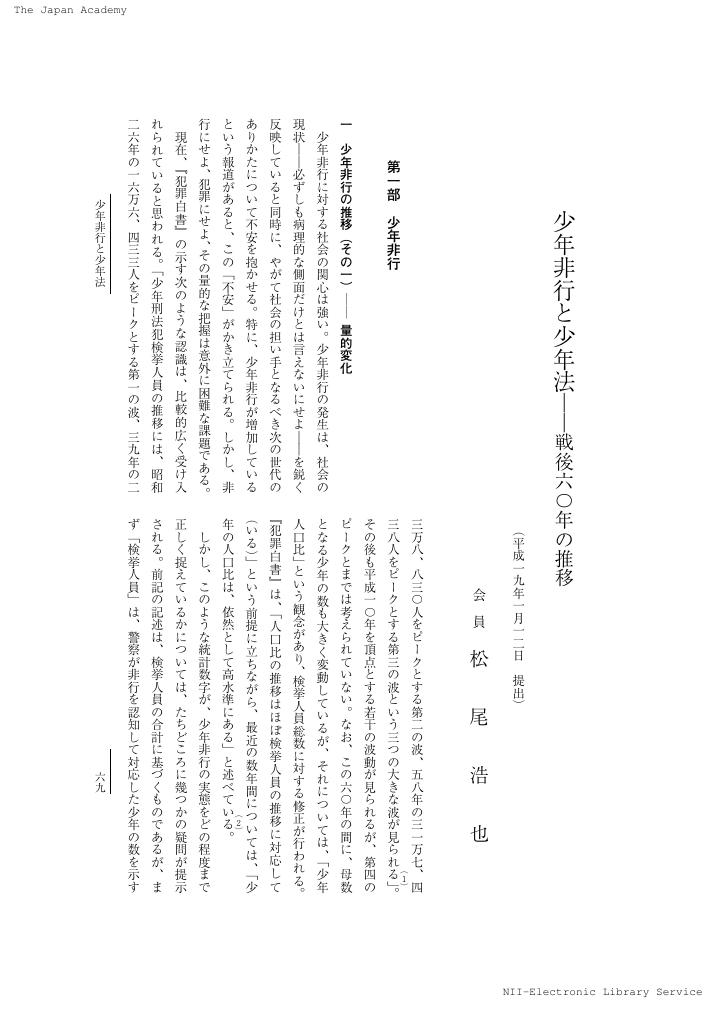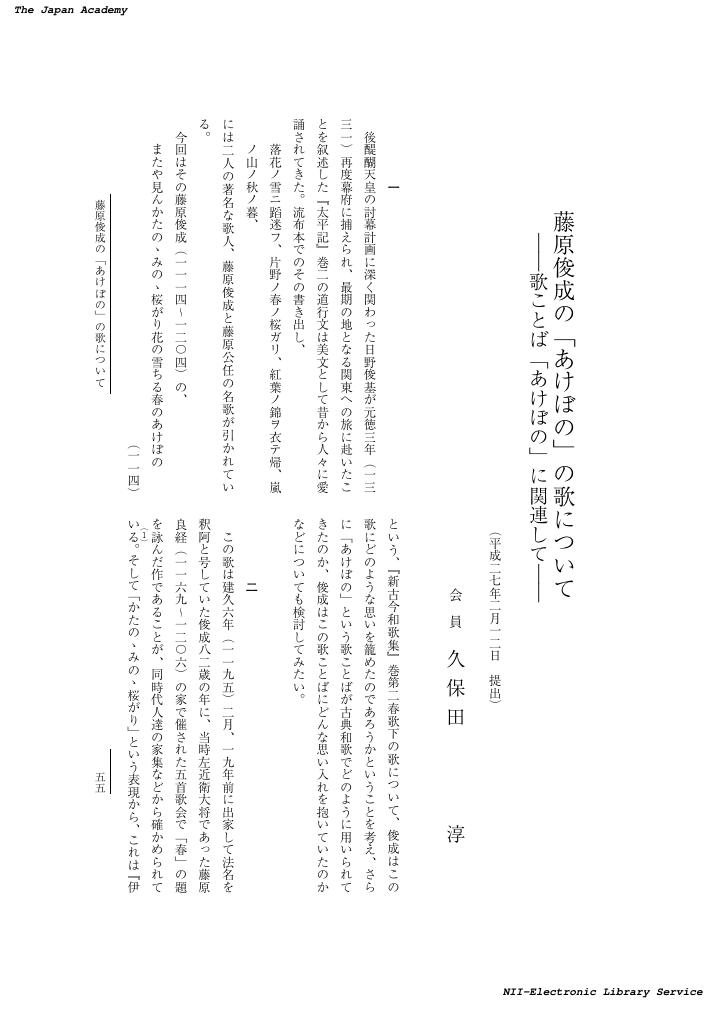2 0 0 0 OA 小野組の研究 (昭和四十二年六月十二日 会員 本庄栄治郎 紹介)
- 著者
- 宮本 又次
- 出版者
- 日本学士院
- 雑誌
- 日本學士院紀要 (ISSN:03880036)
- 巻号頁・発行日
- vol.25, no.3, pp.177-191, 1967 (Released:2007-05-30)
2 0 0 0 OA 近世の日朝関係
- 著者
- 田代 和生
- 出版者
- 日本学士院
- 雑誌
- 日本學士院紀要 (ISSN:03880036)
- 巻号頁・発行日
- vol.72, no.Special_Issue, pp.251-260, 2018-04-11 (Released:2018-05-23)
2 0 0 0 OA ハングルとその起源 (昭和六十三年二月十二日 提出)
- 著者
- 河野 六郎
- 出版者
- The Japan Academy
- 雑誌
- 日本學士院紀要 (ISSN:03880036)
- 巻号頁・発行日
- vol.43, no.3, pp.101-122, 1989 (Released:2007-06-22)
The Korean alphabet is now called“Han-gul”which means in Korean“the great writing”. But this appellation is of recent origin. Formerly it was commonly named“On-mun”(the vernacular writing) . The real name of the writing at the outset was“Hunmin-chong'um”which means“the correct sounds with which the people should be instructed”.
2 0 0 0 禅宗の官寺機構
- 著者
- 今枝 愛真
- 出版者
- 日本学士院
- 雑誌
- 日本學士院紀要 (ISSN:03880036)
- 巻号頁・発行日
- vol.19, no.3, pp.89-122, 1961
2 0 0 0 江戸時代の日本とオランダ
- 著者
- 松井 洋子
- 出版者
- 日本学士院
- 雑誌
- 日本學士院紀要 (ISSN:03880036)
- 巻号頁・発行日
- vol.72, pp.273-285, 2018
- 被引用文献数
- 1
- 著者
- Yoko MATSUI
- 出版者
- The Japan Academy
- 雑誌
- 日本學士院紀要 (ISSN:03880036)
- 巻号頁・発行日
- vol.72, no.Special_Issue, pp.139-154, 2018-04-11 (Released:2018-05-23)
- 被引用文献数
- 1
2 0 0 0 OA 人口転換論を再考する
- 著者
- 斎藤 修
- 出版者
- 日本学士院
- 雑誌
- 日本學士院紀要 (ISSN:03880036)
- 巻号頁・発行日
- vol.73, no.1, pp.1, 2018 (Released:2018-10-11)
- 参考文献数
- 81
Mortality decline, the first phase of the demographic transition, has long been considered a transition triggered by the industrial revolution. This paper is an attempt to question this traditional view, putting forward a set of arguments, first, that the mortality transition was a longer process than conventionally thought, starting a century earlier than the onset of modern economic growth, and second, that a substantial increase in the level of life expectancy at birth, a summary measure of age-specific mortality rates, was indeed a prerequisite of modern economic growth and, hence, of fertility transition, the second phase of the demographic transition. The article begins with a brief overview of the historiography in demography, epidemiology and medical history. Much effort has been made to account for the historical process of mortality decline, and from the past debates there are a couple of lessons learned. One is that while medical progress can no longer explain the early decline in mortality, public health measures are likely to have played an important part. The other is that there is not much evidence to support the claim that economic development led to reductions in death rates. The demographer Samuel Preston demonstrated, by assembling country data on both life expectancy at birth and national income per capita for the 1930s and the 1960s, that the curve representing the relationship between the two factors (called the Preston curve) shifted significantly upwards between the two time-periods. According to his analysis of inter-temporal shifts, income growth per se explained only 16 per cent of the rise in longevity while a bundle of other factors accounted for 84 per cent; and the only variable that had a statistically significant correlation with the gain in life expectancy was the initial level of income – though, contrary to the expectation, its sign was negative. There are also suggestions by historians that in earlier stages where epidemics were more frequent nutrition is unlikely to have been a decisive factor to bring the level of mortality down. According to a recent synthesis in evolutionary biology of pathogens, there is a trade-off between their lethality and transmission potential. Diseases with high lethality, such as plague and smallpox, do not usually depend on their human host for transmission, whereas pathogens that are transmitted person to person but cannot persist outside the host are under strong selective pressure against high host lethality. Based on this conceptual framework as well as stylised facts from English historical demography, Romola Davenport of the Cambridge Group for the History of Population and Social Structure argues that infectious diseases reduced or eliminated in periods before 1870 are those of the first type, while childhood infections and other diseases that lingered on into the first half of the twentieth century are of the second type. Indeed, the Cambridge Group’s path-breaking work on the historical demography of England, c.1540-1870, reveals that from the late seventeenth century onwards adult, child and neonatal mortality rates started to decline but the post-neonatal mortality rate did not. Over the long run, in other words, deaths from pestilence and famine were reduced, thanks to early modern economic growth or the implementation of rudimentary measures in public health by government authorities, or both, while exposure to infection was on the rise, suggesting that the long-term decline of mortality started well before the industrial revolution, but the process became prolonged as industrialisation and urbanisation progressed. (View PDF for the rest of the abstract.)
2 0 0 0 OA 少年非行と少年法 : 戦後六〇年の推移
- 著者
- 松尾 浩也
- 出版者
- 日本学士院
- 雑誌
- 日本學士院紀要 (ISSN:03880036)
- 巻号頁・発行日
- vol.62, no.1, pp.69-80, 2007 (Released:2017-04-05)
2 0 0 0 中国における叙事詩から戯曲への道 : 英雄祭祀と英雄劇
- 著者
- 田仲 一成
- 出版者
- 日本学士院
- 雑誌
- 日本學士院紀要 (ISSN:03880036)
- 巻号頁・発行日
- vol.66, no.1, pp.1-29, 2011
2 0 0 0 OA 藤原俊成の「あけぼの」の歌について : 歌ことば「あけぼの」に関連して
- 著者
- 久保田 淳
- 出版者
- 日本学士院
- 雑誌
- 日本學士院紀要 (ISSN:03880036)
- 巻号頁・発行日
- vol.70, no.1, pp.55-70, 2015 (Released:2017-04-05)
- 著者
- 小田 滋
- 出版者
- 日本学士院
- 雑誌
- 日本學士院紀要 (ISSN:03880036)
- 巻号頁・発行日
- vol.62, no.1, pp.43-68, 2007
- 著者
- 岡 義武
- 出版者
- The Japan Academy
- 雑誌
- 日本學士院紀要 (ISSN:03880036)
- 巻号頁・発行日
- vol.36, pp.21-26, 1979
2 0 0 0 OA 行政法概念の諸相 : 中核と周辺
- 著者
- 塩野 宏
- 出版者
- 日本学士院
- 雑誌
- 日本學士院紀要 (ISSN:03880036)
- 巻号頁・発行日
- vol.66, no.1, pp.47-65, 2011-09
2 0 0 0 OA アダム•スミスの「見えない手」について (平成七年十月十二日 提出)
- 著者
- 小林 昇
- 出版者
- 日本学士院
- 雑誌
- 日本學士院紀要 (ISSN:03880036)
- 巻号頁・発行日
- vol.50, no.3, pp.163-186, 1996 (Released:2007-06-22)
What I intend to do in this article is critically to examine Adam Smith's idea of‘invisible hand’, following the passages in which the phrase appears.As is known well, the phrase‘an invisible hand’appears three times, that is to say, once each in EPS, TMS and WN. Its appearance in EPS, however, does not imply any particular problem. And in the case of WN, there is also a place where the phrase is only implied, i. e. in its Book III, Chap. V (cf. A. Skinner, Introduction to the Pelican[Penguin]Classicsed. of the WN.).In TMS the phrase‘invisible hand’is made use of surrounded by the ancient Stoic creed on which the philosopher Smith is based. In that sense the phrase is outside the theory of sympathy which constitutes the basis of TMS, and the theory of so-called‘deception’used there in the sense that men's misfortune, mistakes and mere selfish acts contribute to the realization of the harmony of the whole society is not sufficient for the possibility of the formation of modern exchange economy society.In WN the phrase‘an invisible hand’totally implies a force to bring about an eventual harmony and welfare in the modern liberal society, and the function of this force is based on the formation of the theories of natural course (order) of the employment of capital. However, the collapse of the theory as such is evident. Moreover, since J. Viner's treatise pointed out, it is well known that Smith is not exhaustive in the criticism of so-called mercantilism, the work of the‘invisible hand’is confined.In Book III of WN, a transcendental power is talked of to cause a great revolution by its action on unworthy common men, where Smith's historical philosophy is evinced which somehow resembles Hegel's‘List der Vernunft’. But such a work in fact of the‘invisible hand’appears only once, and merely implicitly in WN so that Smith's elucidation here does not have universal validity.Quite naturally, the phrase‘an invisible hand’is a symbolic term which a particular age gave birth to and therefore, so far as it goes it can be the object of academic analysis but not its means.
2 0 0 0 カースト--その多様性と変移性
- 著者
- 中根 千枝
- 出版者
- The Japan Academy
- 雑誌
- 日本學士院紀要 (ISSN:03880036)
- 巻号頁・発行日
- vol.56, no.2, pp.65-89, 2002
This essay presents my view on caste as derived from my long experience as an anthropologist in India, which dates back to 1953. My fieldwork has been directed at the Hindu family and village community, not necessarily at caste <i>per</i> <i>se</i>. Nevertheless, it was the working of caste society that provided considerable stimulation to my analytical thought process. My understanding of caste also owes to works by Western and Indian social anthropologists, who have since the 1950s contributed most to the study of caste, and with whom I have enjoyed close contacts as colleagues.<br>This essay consists of four successive parts. (1) Caste-<i>Varna</i> and <i>Jati</i>. Both are called"caste, "though they have different historical backgrounds as well as different connotations. In actual Hindu life, caste is articulated as <i>jati</i>, numerous primary functional groups variously classified by occupation (as explained in the next section). Simultaneously, <i>jati</i> members also have a strong concern with <i>varna</i>, i.e. the four status groups of Brahman, Kshatriya, Vaisha and Sudra, as clearly stated in ancient Vedic literature. People desire to interpret their <i>jati</i> within a <i>varna</i> classification. This is particularly the case with Kshatriya, in order to profess a higher status. In this paper, the term"caste"refers to <i>jati</i> or a cluster of the same kind of <i>jati</i>.
- 著者
- 天皇陛下
- 出版者
- 日本學士院
- 雑誌
- 日本學士院紀要 (ISSN:03880036)
- 巻号頁・発行日
- vol.62, no.2, pp.131-140, 2007-11
2 0 0 0 OA 社会階級・社会階層と経済社会学
- 著者
- 富永 健一
- 出版者
- 日本学士院
- 雑誌
- 日本學士院紀要 (ISSN:03880036)
- 巻号頁・発行日
- vol.68, no.2, pp.139-179, 2014-02
2 0 0 0 戦前日本のアメリカ研究 : 素描
- 著者
- 斎藤 眞
- 出版者
- 日本学士院
- 雑誌
- 日本學士院紀要 (ISSN:03880036)
- 巻号頁・発行日
- vol.55, no.2, pp.81-103, 2000
- 著者
- 久保 正彰
- 出版者
- 日本学士院
- 雑誌
- 日本學士院紀要 (ISSN:03880036)
- 巻号頁・発行日
- vol.61, no.2, pp.45-64, 2007-01
2 0 0 0 OA “Human Rights”と“droits de l'homme”の含意をめぐって
- 著者
- 樋口 陽一
- 出版者
- 日本学士院
- 雑誌
- 日本學士院紀要 (ISSN:03880036)
- 巻号頁・発行日
- vol.57, no.2, pp.47-63, 2002 (Released:2007-06-22)
Quant au terme de“droits de l'homme”, notion clé du constitutionnalisme contemporain, it faut bien distinguer entre les deux. Les droits de l'homme lato sensu peuvent se définir comme une revendication, regardée légitime, pour la possibilité de mener une vie d'une façon humaine. Le terme anglais Human Rights aurait d'ailleurs cette résonnance. Or, queue est la façon humaine de mener une vie? La réponse dépendrait du contenu de l'adjectif “humain”, et elle serait nécessairement variable d'une culture à l'autre. À l'extrême, être tout dévoué à la communauté à laquelle on appartient, pourrait être regardé comme la manière la plus “humaine”de vivre dans telle ou telle société.S'agissant des droits de l'homme stricto sensu, ils présupposeraient, comme titulaire des droits, l'individu“doppelfrei”, libéré à la fois de l'oppression et de la protection des corps statutaire et féodal. Les droits de l'homme, entendus dans ce sens strict, sont les produits historiques de la modernité individualiste d'origine occidentale. Ile ne peuvent pas être dissociés de la notion de l'individu qui se décide et qui assume la conséquence de sa propre décision, tandis que les droits de l'homme lato sensu pourraient s'adapter à une conception plus on moms communautariste.Les droits de l'homme stricto sensu exige ainsi une manière de vivre qui semblerait, du point de vue de certaines cultures, être plutôt“inhumaine”. Même au sein de la zone culturelle occidentale, la croyance en la vertue de l'individu se trouve de moins en moins certain, et la tentation même à la démission de l'individu risque de se propager (“Escape from Freedom”).Ainsi, un sceptisme à l'égard de la notion de l'homme titulaire des droits de l'homme stricto sensu fermente, depuis des decennies, dans le milieu intellectuel. L'accusation est lancée surtout del apart du femminisme et du multiculturalisme d' après laquelle la notion même des droits de l'homme serait anachronique et dépassée.Tout en respectant la pluralité des cultures en général, comment défendre le noyau essentiel des droits de l'homme, la liberté reconnue à chacune et à chacun de choisir sa propre identité? La culture des droits de l'homme peut se concilier avec l'exigence légitime de la pluralité des cultures, tant que ces dernières acceptent ce noyau dur. Or, il ya bien des cultures qui refusent, au nom de leur tradition ou de leur identité collective, la prémisse même d'une coexistence avec la culture des droits de l'homme. Le véritable enjeu émerge ainsi.







